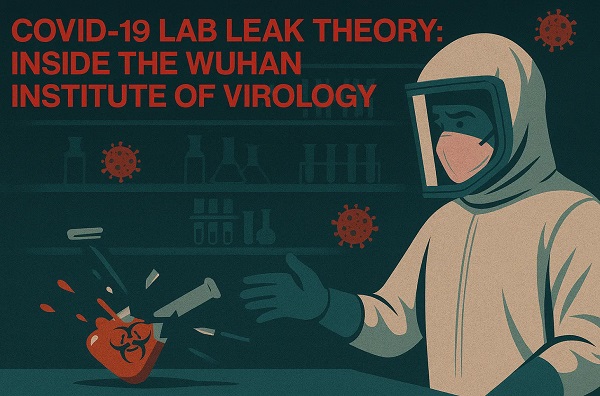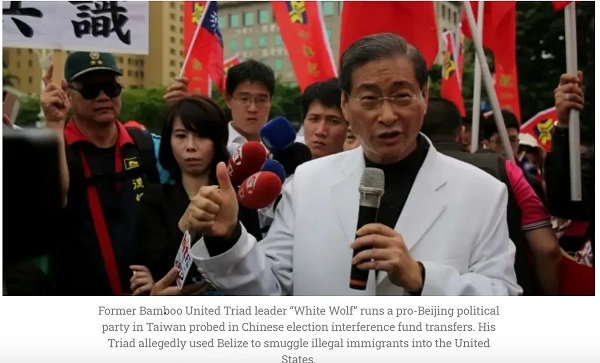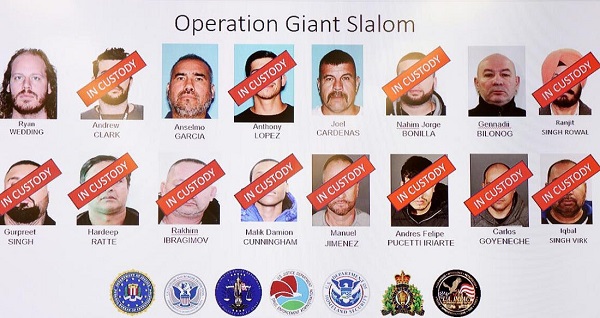espionage
Beijing’s Secret Biowar: National Security Experts Probe Fentanyl and Expanding Viral Bioweapons Program After COVID-19 Lab Leak

A new book argues that Beijing transformed a pandemic lab leak into a global field test — and is now accelerating bioweapons development and fentanyl production from Pakistan to Wuhan.
In 2022, synthetic opioids killed more than 75,000 Americans. But according to the authors of China’s Total War Strategy: Next-Generation Weapons of Mass Destruction, these fentanyl deaths were not simply the result of regulatory failures or a national addiction crisis. They were casualties in a covert biochemical war — one that Western governments remain unwilling to confront. This war, the authors argue, is not waged by rogue actors, but directed by the strategic command of the Chinese Communist Party, wielding an arsenal that includes fentanyl, cognitive warfare, genetically engineered viruses — including the bat coronavirus they say leaked accidentally from Wuhan and was later weaponized through statecraft — and a global criminal underworld mobilized as an instrument of policy.
“This is strategic activity that is driven by hostile state intent,” the authors write, referring to opioid trafficking networks that fuse China’s state-backed chemical supply chains with the industrial-scale production infrastructure of Mexican cartels.
They describe the fentanyl epidemic as “biochemical warfare against a highly clustered group of Western countries” — with the Five Eyes nations as primary targets — and argue that synthetic narcotics can no longer be viewed solely through the lens of organized crime. Instead, they should be understood as instruments in a state-enabled campaign of mass disruption orchestrated by Beijing.
Within the book’s evidentiary framework, China’s alleged fentanyl campaign — paired with the global consequences of the COVID-19 pandemic — emerges as the most consequential demonstration to date of what the authors describe as Beijing’s increasingly effective total war doctrine.
The thesis is unflinchingly dark, confrontational — and, to many readers, will seem conspiratorial. Yet the authors, a team of American national security and military intelligence veterans, construct their case with layers of evidence and the methods of intelligence tradecraft. They connect the Chinese Party-state’s export of fentanyl precursor chemicals and chemical engineering expertise to Mexican cartels, its cognitive warfare operations on Western social media platforms, and its role in the COVID-19 pandemic — forging these seemingly disparate elements into a predictive model of how the Chinese Communist Party is reengineering modern warfare.
This doctrine of clandestine total war, rooted in Chinese military texts, assumes that Beijing — which has signaled intentions to invade Taiwan as early as 2027 — cannot prevail in a conventional conflict against a coalition that may include the United States, Japan, Taiwan, Australia, South Korea, and the United Kingdom. Instead, the strategy prioritizes asymmetric, non-kinetic warfare designed to degrade an adversary’s societal resilience, probe its critical systems, and map its crisis response — all before open conflict begins.
The Bureau is a reader-supported publication.
To receive new posts and support my work, consider becoming a free or paid subscriber.
Cognitive War and Elite Capture
The unfolding shadow war — and the development of next-generation clandestine weapons — is, the authors argue, being waged behind the smokescreen of foreign interference and influence operations. Total War Strategy outlines a multi-track offensive: some elements are deniable yet increasingly brazen and visible, while others remain deeply concealed and poorly understood.
The visible front includes familiar forms of state aggression — industrial espionage, economic coercion, transnational repression, intellectual property theft, election interference, and the covert financing of protest movements. The second, more insidious track, is cognitive warfare: the manipulation of information systems, digital platforms, and social media networks to fracture democratic cohesion and weaken public trust from within. China’s influence operations, according to the authors, serve not merely to shape narratives but to provide cover for far more dangerous strategic objectives.
They cite a pattern of “targeted influence campaigns to undermine, corrupt, persuade and destabilize regimes such as Brazil, Mexico, Canada, Panama, some European Union states and many Sub-Saharan African nations.” These efforts are complemented by sustained economic coercion, intimidation of diaspora communities, trafficking in weapons and narcotics, and the exploitation of academic and technological partnerships — all deployed as tools of indirect warfare.
“Such non-lethal efforts in unsuspecting societies and regimes often succeed,” the authors write, “because feckless leaders are too naive to grasp the insidious assassin’s mace approach.”
In this argument, fentanyl is a primary weapon — and states like Canada remain in denial about their institutional role in enabling the shift of Chinese production and trafficking routes.
Seen through the lens of North America’s fentanyl crisis — in which hundreds of thousands have died while policymakers continue to treat the emergency as a public health or law enforcement issue — the authors argue the Chinese Communist Party is already attacking Western defenses via transnational crime proxies.
“These hostile state extensions are engaged in biochemical warfare against a tightly clustered group of Western countries,” they write. “The effects have been devastating but are fragile and reversible once the massive information asymmetries regarding network structure are rebalanced. The successful collapse of these syndicates in the Five Eyes nations will reduce the likelihood of spread to other countries. The inverse is also true.”
The fentanyl trade, they argue, defies the logic of conventional criminal markets. Unlike heroin or cocaine, synthetic opioids annihilate their own user base. “Fentanyl-laced heroin does not generate a stable population of consumers,” they note, “given the high fatality rates of users.” In a rational market, a drug enterprise seeks to cultivate long-term demand. Fentanyl destroys it. And yet, production and distribution continue to scale exponentially.
Unlike traditional cartels, which can be disrupted through leadership arrests or financial seizures, a state-backed trafficking network is more resilient, adaptive, and strategically dangerous. The CCP’s role — supplying precursor chemicals, trafficking infrastructure, and, in some cases, managerial oversight — elevates the threat from criminal to geopolitical.
That threat, they note, is not evenly distributed. The most devastating effects of synthetic narcotics are concentrated in the Five Eyes intelligence alliance: the United States, Canada, the United Kingdom, Australia, and New Zealand. Europe, despite its liberalized approach to drug markets, has seen no comparable surge in fentanyl fatalities — yet.
COVID-19: Accident Evolves into ‘Field Test’
The authors’ thesis is stark: China’s covert bioweapons program did not merely survive the COVID-19 pandemic — it accelerated, diversified, and deepened in its aftermath.
While much of the world remains fixated on the Wuhan Institute of Virology as the plausible origin point of the COVID-19 crisis, the authors caution that Wuhan was only one node in a vast and opaque network.
Drawing on open-source intelligence, forensic research, and a review of Chinese scientific literature, the authors contend that the Chinese Communist Party has dramatically expanded its clandestine biological weapons program across multiple pathogen types and geographic locations — including, notably, a military-linked facility in Islamabad, Pakistan. Their analysis synthesizes pre- and post-pandemic data, Chinese-language publications, patent filings, and sensitive research documents — some of which disappeared from public access shortly after surfacing.
To build their case, the authors first established a pre-COVID baseline of biological research activity in China, then overlaid post-pandemic developments. What emerges, they argue, is a sprawling, dual-use biological weapons network spanning labs in Wuhan, Harbin, and Beijing — embedded within China’s vast research infrastructure and operated under both civilian and military auspices. Their findings surpass what has been publicly disclosed by Western governments, though they align with intelligence assessments from the United Kingdom, Germany, the FBI, and now the CIA.
According to the authors, the original SARS-CoV-2 outbreak was the result of an accidental lab leak at the Wuhan Institute of Virology in late 2019. They tie the incident to a long-documented pattern of high-risk bat coronavirus gain-of-function experiments conducted at the institute — many of which, they argue, fall within the broader scope of the People’s Liberation Army’s biological warfare program. That program, they assert, enjoys top-level political and military protection from Major General Chen Wei — a senior figure in the CCP’s elite scientific apparatus — whose subordinates have collaborated freely with researchers in Canada and the United States under the guise of pandemic preparedness.
This claim aligns with intelligence findings from CSIS, Canada’s national security agency, and several of its Five Eyes counterparts. But the authors go further: they assert that rather than responding transparently to the accidental lab leak in Wuhan, the Chinese regime quickly adapted — transforming a domestic crisis into a global strategic opportunity.
According to their analysis, CCP-linked intelligence services closely monitored how other nations — including the United States and its allies — responded to the pandemic across public health, economic, and defense sectors. This real-time surveillance, the authors suggest, turned COVID-19 into a de facto field test: a live demonstration of how resilient the West would be in the face of sudden, high-impact biological disruption — and how such disruption could be exploited.
Crucially, they stress that China’s bioweapons research is not limited to coronaviruses. On the far more dangerous end of the threat spectrum, they say, the CCP is pursuing weaponization of high-fatality pathogens such as Nipah virus and African swine fever. Even within the SARS-CoV-2 family, the work continues. One January 2024 study, cited by the authors, describes a new synthetic variant engineered at the Beijing University of Chemical Technology — work they suggest poses even greater risks than the original pandemic strain.
Perhaps most alarming is the convergence they document between genetic engineering and delivery technologies. The CCP, the authors assert, is pairing its pathogen research with advanced nanotechnology platforms — opening the door to next-generation weapons that are more targeted, more concealable, and far more difficult to defend against. Supporting evidence includes experimental data and patent filings that demonstrate efforts to bind engineered viruses with nanoparticles designed for precise delivery.
Even if only portions of the authors’ findings and predictions prove accurate, the book’s well-supported claims suggest that governments — from Washington to Taipei, Berlin, Ottawa, and Canberra — should be urgently educating their populations about the realities of hybrid warfare campaigns waged by Beijing and other hostile states. At a minimum, they should be intensifying preparations for the plausible — if nightmarish — scenarios that Total War Strategy outlines.
With millions already dead since 2020 from the bat coronavirus pandemic and the fentanyl epidemic — both of which, even the most cautious experts acknowledge, trace back to Chinese sources, whether intentionally produced or not — anything less than a serious, studied response to the theory and evidence presented in Total War Strategy would constitute a dangerous dereliction of duty.
Authors Dr. Ryan Clarke, LJ Eads, Dr. Robert McCreight, and Dr. Xiaoxu Lin are national security experts with diverse government and professional backgrounds, and co-founders of the CCP BioThreats Initiative.
espionage
Inside Xi’s Fifth Column: How Beijing Uses Gangsters to Wage Political Warfare in Taiwan — and the West

A new Jamestown Foundation report details how China’s Ministry of State Security and allied triads have been used to subvert Taiwan’s democracy as part of Beijing’s united front.
Editor’s Note
The Bureau has previously reported on how Chinese state-linked crime networks have exploited Canada’s real estate market, casinos, and diaspora associations, often under the cover of united front work. One of these groups, the Chinese Freemasons, has been linked to meetings with Canadian politicians, as reported by The Globe and Mail ahead of the 2025 federal election. The Globe noted that the Toronto chapter explicitly advocates for the “peaceful reunification of Taiwan.” The Jamestown Foundation’s new findings on groups active in Taiwan — including the Chinese Freemasons, also known as the Hongmen, the related Bamboo Union triad, and the China Unification Promotion Party (CUPP) — show that Taiwan is the epicenter of a strategy also visible, though less intensively, across democracies including the United States. The parallels — from Vancouver to Sydney to New York to Taipei — should alert governments that the “fifth column” problem is international, and it is growing.
TAIPEI — At a banquet in Shenzhen more than two decades ago, Chang An-lo — the Bamboo Union boss known as “Big Brother Chang” or “White Wolf” — raised a glass to one of the Communist Party’s princelings. His guest, Hu Shiying, was the son of Mao Zedong’s propaganda chief. “Big Brother Chang,” Hu reportedly toasted him, an episode highlighted in a new report from the Jamestown Foundation.
Hu would later be described by Australian journalist John Garnaut as an “old associate of Xi Jinping.” That link — through Hu and other princelings Chang claimed to have met — placed the Bamboo Union leader within the orbit of Party elites. Garnaut also reported that the Ministry of State Security (MSS) had used the Bamboo Union to channel lucrative opportunities to Taiwanese politicians. According to Jamestown researcher Martin Purbrick, a former Royal Hong Kong Police intelligence officer, such episodes show how the CCP has systematically co-opted Taiwanese organized crime as part of its united front strategy.
“The long history of links between the CCP and organized crime groups in Taiwan,” Purbrick writes, “shows that United Front strategy has embedded itself deeply into Taiwan’s political life.”
Chang’s global influence is not a relic of the past. The Bureau reported, drawing on leaked 1990s Canadian immigration records, that intelligence indicated Chang’s triad had effectively “purchased” the state of Belize, on Mexico’s southern border, for use in smuggling illegal immigrants into the United States. But Chang is more relevant than ever as fears of Beijing invading Taiwan grow. In August 2025, seated in his Taipei office before a PRC flag, he appeared on a YouTube program to deny he led any “fifth column.” Instead, he insisted Taiwan must “embrace” Beijing and cast himself as a “bridge for cross-strait peace.”
His denial came just months after Taiwan’s Ministry of Justice accused CUPP of acting as a political front for organized crime and foreign interference. Police suspected more than 130 members of crimes ranging from homicide to drug trafficking. Prosecutors charged CUPP operatives with taking $2.3 million from the CCP to fund propaganda. In January, the Ministry of the Interior moved to dissolve the party outright, submitting the case to Taiwan’s Constitutional Court. By March, a Kaohsiung court sentenced CUPP deputy secretary-general Wen Lung and two retired military officers for recruiting Taiwanese personnel on behalf of the PRC. According to court filings, Wen had been introduced by Chang to the Zhuhai Taiwan Affairs Office, which in turn connected him to a PLA liaison officer.
President Lai Ching-te, in a March national security address, warned that Beijing was attempting to “divide, destroy, and subvert us from within.” Intelligence assessments in Taipei describe the Bamboo Union and CUPP as part of a potential “fifth column,” prepared to foment unrest and manipulate opinion in the event of an invasion.
The historical record shows why Taipei is so concerned. Chang’s name has shadowed some of Taiwan’s darkest chapters. In the 1980s, he was suspected of involvement in the assassination of dissident writer Henry Liu in California. He was later convicted of heroin smuggling in the United States, serving ten years in prison. After returning to Taiwan, he fled again in 1996 when authorities sought his arrest, spending 17 years in Shenzhen. During those years, he cultivated ties with influential Party families. At the Shenzhen banquet, Washington Post journalist John Pomfret wrote, Hu Shiying introduced him as “Big Brother Chang,” signaling acceptance in elite circles. Garnaut, writing over a decade later, noted that Hu was an “old associate of Xi Jinping” and that Chang had moved comfortably among other princelings, including sons of a former CCP general secretary and a top revolutionary general.
These connections translated into political capital. When Chang returned to Taiwan in 2013, he launched the China Unification Promotion Party — a pro-Beijing group openly advocating “one country, two systems.” He declared his mission was to “cultivate red voters.” CUPP cadres and Bamboo Union affiliates became visible in street politics, clashing with independence activists and disrupting rallies. During U.S. Speaker Nancy Pelosi’s 2021 visit, they staged counter-protests echoing Beijing’s line.
The ideological warfare runs even deeper. A Phoenix TV segment from 2011 recalled how a Bamboo Union elder declared in 1981 that he “would rather the CCP rule Taiwan than have Taiwan taken away by Taiwan independents.” Chang himself has echoed this sentiment for decades. In 2005, he launched a Guangzhou-based group called the Defending China Alliance, later rebranded in Taipei as CUPP. His activism has spanned disruptive protests, nationalist rallies, and propaganda campaigns amplified through China-linked media channels.
Purbrick situates these developments within a wider united front playbook. Taiwanese triads and Chinese Freemason associations are courted as grassroots mobilizers, intermediaries, and psychological enforcers. A recent report from the Washington Post has also linked the Chinese Freemasons to the powerful 14K Triad, a global network deeply implicated in Chinese underground banking networks accused of laundering fentanyl proceeds for Mexican cartels through the United States. The triad–Hongmen nexus complements other CCP efforts: online influence campaigns, cultural outreach, and intelligence recruitment inside Taiwan’s military.
The implications extend beyond Taiwan. In Canada, Australia, the United States, Southeast Asia, and beyond, intelligence agencies have documented how PRC-linked triads launder drug profits, fund political donations, and intimidate diaspora critics. These groups benefit from tacit state protection: their criminality overlooked so long as they advance Beijing’s strategic objectives. It is hybrid warfare by stealth — not soldiers storming beaches, but criminal syndicates reshaping politics from within.
For Taiwan, the Bamboo Union and CUPP remain immediate threats. For other democracies, they serve as case studies of how united front tactics adapt across borders. President Lai’s warning that Beijing seeks to “create the illusion that China is governing Taiwan” resonates internationally.
Before leaving journalism to establish an advisory firm, John Garnaut himself became entangled in the political fallout of his reporting. He was sued by a Chinese-Australian real estate developer from Shenzhen, who had funneled large donations to Australian political parties. The developer, later publicly implicated in the case by an Australian lawmaker under parliamentary privilege, successfully sued Garnaut for defamation in 2019. Subsequent disclosures confirmed the tycoon’s implication in an FBI indictment involving United Nations influence schemes and notorious Chinese operative Patrick Ho, later linked to a Chinese oil conglomerate accused of targeting the Biden family in influence operations. Together, these episodes highlight the global reach of united front networks.
Business
A Nation Built on Sand: How Canada Squanders Its Abundance

By Garry Clement
Columnist Garry Clement, former RCMP anti–money laundering expert, argues Canada’s leaders have built prosperity on sand — leaving the nation exposed to collapse unless urgent reforms are made.
Canada is celebrated abroad as a safe, prosperous, and open society. But beneath the surface, a far more precarious reality is taking shape. The pillars of our economy — land, real estate, natural resources, and immigration — have been left vulnerable to foreign manipulation, criminal exploitation, and political negligence. The result is what can only be described as a sandcastle economy — striking at first glance, but fragile. Like the parable of the house built on sand, it is a foundation vulnerable to give way when the storm comes.
Investigative journalist Sam Cooper has long warned that foreign capital and organized crime have deeply infiltrated Canada’s real estate market. On Prince Edward Island, the Bliss and Wisdom Buddhist group quietly acquired swaths of farmland and property, raising questions about how religious fronts with Chinese connections gained such leverage in a province with limited oversight. In Saskatchewan, Chinese investors have been buying up valuable farmland, raising alarms about food sovereignty and the lack of restrictions on foreign ownership of agricultural land. Meanwhile in British Columbia, governments continue to downplay or outright ignore the extent to which transnational money laundering has fueled a housing market now completely detached from local incomes.
All of this has unfolded against a backdrop of minimal transparency, weak beneficial ownership registries, and virtually no effective enforcement. The same blind spots that allowed casinos and luxury real estate in Vancouver to become laundromats for dirty money are now being replicated nationwide.
The most urgent threat tied to these financial blind spots is fentanyl. Canada has become one of the world’s top destinations for proceeds from synthetic drug trafficking — a crisis that has devastated families from coast to coast. Chinese triads, Mexican cartels, and local gangs launder profits through casinos, shell companies, and real estate deals. Yet federal legislation continues to lag behind, leaving law enforcement outgunned. Every toxic opioid death in Canada is not only a health tragedy, but also a reminder of how organized crime is exploiting our lax financial controls. While other countries have implemented tough anti-money laundering regimes, Canada remains dangerously complacent.
That same complacency extends to national security. Canada has repeatedly delayed designating Iran’s Islamic Revolutionary Guard Corps as a terrorist organization, despite overwhelming evidence of its involvement in financing terrorism and conducting influence operations abroad. Our allies — including the United States — have acted. Canada, however, remains an outlier, seemingly unwilling to confront the risk of Iranian proxy activity operating in plain sight within our borders.
Immigration policy reveals similar weaknesses. Foreign students, particularly from India, have become central to the financial survival of colleges and universities. Yet a growing number are not here primarily to study. Instead, education visas have become a backdoor into Canada’s workforce, particularly in industries such as trucking. The tragic Humboldt Broncos bus crash in 2018 exposed gaps in training and licensing in the trucking sector. Since then, reports have continued to surface of foreign students entering the industry without adequate skills — a risk not only to public safety but to the integrity of our immigration system. Ottawa has failed to adequately regulate this pipeline, preferring instead to rely on the tuition dollars and temporary labour it generates.
Editor’s Note: Forthcoming Bureau investigations, citing U.S. government sources, question how widespread fraud and Indian transnational crime capture of Canada’s commercial trucking industry have fueled the flow of fentanyl, cocaine, and methamphetamine — turning the country into a weak link for its international allies.
The threads running through these crises are clear: willful blindness, weak laws, and short-term political expediency. Land and natural resources are being sold without regard for sovereignty. Real estate markets are distorted by laundered money. Organized crime groups funnel fentanyl profits into Canada with ease. The IRGC operates without effective restriction. And the education system is exploited as a labour channel, with little oversight. Canada is, in effect, trading away its long-term security for short-term economic gains.
Politicians, bureaucrats, and regulators too often dismiss warnings as alarmist or xenophobic, when in fact they reflect real risks to the stability of the country. A sandcastle can stand tall on the shore, admired in the moment, but everyone knows what comes next. Unless urgent steps are taken — enforcing transparency in land ownership, restricting foreign control of farmland and resources, tightening anti-money laundering measures, confronting hostile foreign actors, and restoring integrity to the education and immigration systems — collapse is inevitable.
The signs are already here: families priced out of homes, farmers squeezed out of land, fentanyl overdoses climbing, and a public losing faith in the fairness of the system. Canada prides itself on being open and inclusive. But openness without vigilance is vulnerability. Like unwise stewards, our leaders have been gifted with a land of overflowing abundance, and yet they have squandered its potential through short-sighted choices. That failure must be corrected — immediately and wisely — if the nation is to not only thrive, but survive.
The Bureau is a reader-supported publication.
To receive new posts and support my work, consider becoming a free or paid subscriber.
Former senior RCMP officer Garry Clement consults with corporations on anti-money laundering, contributed to the Canadian academic text Dirty Money, and wrote Canada Under Siege, and Undercover, In the Shady World of Organized Crime and the RCMP
-

 Business1 day ago
Business1 day agoCarney’s ‘major projects’ list no cause for celebration
-

 Business1 day ago
Business1 day agoGlobal elites insisting on digital currency to phase out cash
-

 Business1 day ago
Business1 day agoRed tape is killing Canadian housing affordability
-

 Health1 day ago
Health1 day agoMAiD should not be a response to depression
-

 Artificial Intelligence1 day ago
Artificial Intelligence1 day agoUK Police Chief Hails Facial Recognition, Outlines Drone and AI Policing Plans
-

 Business1 day ago
Business1 day agoOttawa’s so-called ‘Clean Fuel Standards’ cause more harm than good
-

 Business1 day ago
Business1 day agoThe Truth Is Buried Under Sechelt’s Unproven Graves
-

 International1 day ago
International1 day agoFrance records more deaths than births for the first time in 80 years






